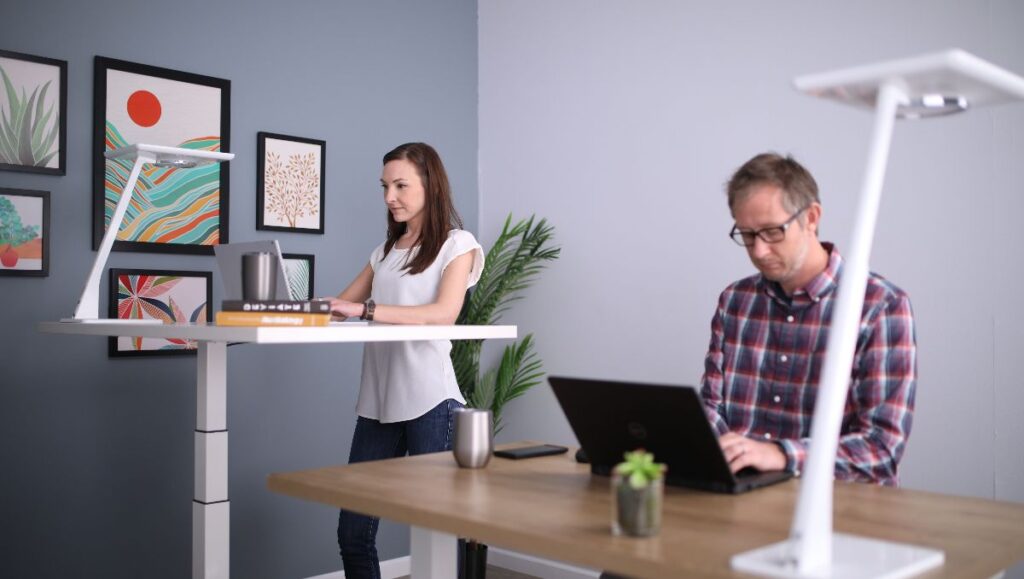Creating a workspace that fosters productivity and comfort begins with selecting the right desk. While aesthetics and functionality play significant roles, the dimensions of your desk are equally crucial. The height, width, and depth of your desk should not only fit your workspace but also accommodate your body and work style. Whether you’re working from home or in a corporate office, choosing the right desk dimensions for your workspace is essential.
Key Takeaways:
- Choose desk dimensions based on your workflow, comfort, and available space to ensure a good fit and ease of use.
- Aligning desk size with your workspace and daily tasks creates an organized, efficient, and productive environment.
- Choosing the right desk design, material, and features ensures a versatile and visually appealing workspace that adapts to evolving needs.
This guide will walk you through the key considerations and provide insights into choosing the perfect desk dimensions tailored to your unique needs.
Ergonomics 101: The Importance of Choosing Proper Desk Dimensions
Choosing the right desk size isn’t just about aesthetics — it’s essential for comfort, posture, and long-term health. An ergonomic desk aligns your body properly, reducing strain on the neck, shoulders, and back, and helping prevent musculoskeletal disorders, which make up about 33% of workplace injuries. Proper desk height and depth also keep your arms and legs comfortable, preventing fatigue during long work hours.
Beyond health, desk size impacts productivity. A desk that’s too small feels cramped, while one that’s too large wastes space. The ideal balance supports focus, efficiency, and comfort. Research by Largo-Wight (2011) shows that well-designed work environments reduce stress and boost satisfaction — proving that the right desk dimensions enhance both productivity and well-being.
Essential Desk Dimensions to Consider for Comfort and Productivity
The key measurements, including height, width, and depth, directly influence how well your desk supports your work habits and overall posture.

Width
The width of your desk significantly impacts your workspace’s functionality. Consider the size of your workspace, the number of monitors you use, and the activities you perform when choosing the width. If you need ample space for drawing, crafting, or multiple monitors, opt for a larger desk.
Depth
Desk depth affects legroom and monitor placement. Standard depths range from 24 to 30 inches wide. To ensure adequate legroom, aim for at least 24 inches of space between the front of the desk and any obstructions. For optimal monitor viewing distance, maintain a distance of 20-40 inches between your eyes and the screen.
Height
Proper desk height is crucial for ergonomic posture. The standard desk height is 29-30 inches wide, suitable for most individuals between 5’8″ and 5’10”. However, if you’re significantly taller or shorter, consider an adjustable height desk.
Different Desk Types and Standard Dimensions for Home and Office
Desks come in various shapes, sizes, and styles, each designed to cater to different needs and work environments.
Standard Rectangular Desks

The classic and most versatile desk type features a simple rectangular shape, offering a clean and uncluttered workspace ideal for a range of tasks. These desks are valued for their versatility, fitting well into most workspaces and providing ample surface area for individual work. However, they may offer limited space for accommodating multiple monitors or facilitating collaborative projects.
L-Shaped Desks

An L-shaped desk features a main desk area with a perpendicular return, forming an L shape that maximizes workspace and creates distinct zones for different tasks. This design offers ample workspace and allows for the separation of tasks into different areas, providing flexibility for various workflows and setups. However, it requires more space and may not be suitable for smaller rooms.
Explore our collection of L-Shaped Desks designed with craftsmanship and care.
U-Shaped Desks

A U-shaped desk, similar to an L-shaped desk but with an additional return on the opposite side, forms a U shape that provides the most expansive workspace and ample storage options. This design maximizes workspace and offers excellent storage solutions, making it ideal for multitasking and collaborative work. However, it occupies a significant amount of floor space, making it best suited for larger rooms.
Standing Desks

A standing desk with an adjustable height mechanism allows you to switch between sitting and standing positions, promoting movement and offering potential health benefits. The ability to alternate positions can help reduce fatigue and improve focus. In a study, researchers found that incorporating sit-stand workstations can lead to increased energy and reduced discomfort among employees. However, transitioning to a new working posture may require some adjustment, and additional accessories, such as an anti-fatigue mat, might be necessary to enhance comfort.
Compact/Writing Desks

Compact or writing desks are often characterized by a simple design and minimal storage. They are ideal for small spaces or focused tasks such as writing or studying. They are also well-suited for limited tasks and can be easily moved and rearranged to fit various settings. However, they offer limited workspace and may not accommodate multiple monitors or extensive setups.
Computer/Gaming Desks

A computer or gaming desk is designed for computer use, often featuring cable management, monitor stands, and ergonomic designs. In a research, ergonomic workstation adjustments, including specialized desks, were shown to reduce musculoskeletal discomfort and improve productivity. However, these desks may be less versatile and bulkier than standard desks.
Credenza Desk

A credenza desk comes with a hutch or cabinet attached provides additional storage and display space for books, files, and decorative items. This setup offers increased organization and can make the workspace more visually appealing. However, the hutch may limit overhead space and might not be ideal for taller individuals or those who prefer a minimalist design.
Executive Desk

Executive desks are large, imposing pieces often crafted from high-quality materials to convey authority and professionalism. These desks provide ample workspace and extensive storage options, making them well-suited for executive tasks. While they project a commanding presence and offer significant functionality, they also require a substantial amount of space and can be quite expensive.
Discover our range of Executive Desks, expertly crafted with precision and attention to detail.
Secretary Desk

A secretary desk is a compact piece of furniture featuring a drop-down front that reveals a writing surface and hidden storage compartments. Its space-saving design is ideal for small areas and offers concealed storage, making it a versatile addition to a room. However, the drop-down front can restrict legroom when extended, and the desk may provide less workspace compared to standard desk dimensions.
Explore a wide selection of ergonomic desks to transform your work experience.

How Desk Materials and Design Impact Size, Comfort, and Workspace Efficiency
When choosing desk dimensions, the material and design play a big role in how your workspace feels and functions. Wood desks are sturdy but often bulky, requiring more room, while metal desks offer sleek frames that save space. Glass desks make small areas feel larger, and laminate desks provide lightweight, versatile options. Design features also impact usable space: minimalist desks maximize legroom, storage-integrated desks require extra width or depth for drawers and shelves, and adjustable or modular desks let you tailor height and layout to your workflow. Understanding these factors ensures your desk fits comfortably without compromising efficiency.
Here’s a table that breaks down the concept better:

Optimizing Desk Size, Layout, and Design for Maximum Productivity
Creating a productive workspace starts with the right desk size, layout, and design. These factors influence posture, organization, and focus throughout the day.
Natural and Task Lighting
Place your desk near a window to benefit from natural light — it boosts mood, energy, and concentration. Avoid direct glare on your screen to prevent eye strain. If natural light is limited, use adjustable task lighting. Warm LEDs work well for reading or writing, while cooler, blue-enriched tones enhance alertness and focus for computer work.
Color and Design
Color plays a subtle but powerful role in how spacious and comfortable your office feels. Researchers found that different colors can influence perceptions of room size, temperature, and overall comfort, shaping how people experience a space.
- Light wood or white desks make smaller areas feel larger and more open.
- Darker tones like walnut or espresso add warmth and sophistication — great for bigger rooms.
- Neutral colors such as beige, gray, or soft blue promote calmness and help reduce distractions.
You might be interested to explore the top benefits of choosing a walnut standing desk.
How to Choose Desk Dimensions That Fit Your Workstyle and Space
Choosing the right desk involves more than just picking a style or color; it’s essential to match the desk dimensions to your specific needs and workspace requirements to ensure both functionality and comfort.
Assess Your Workspace
Using a measuring tape, determine the width and depth of the area where you plan to place your desk. Consider leaving enough space for an ergonomic chair and comfortable movement around the desk. Based on the available space and your preferences, determine the maximum width and depth for your desk.
When measuring:
- Measure the width (side to side) of your desired area.
- Measure the depth (front to back) to ensure enough work surface.
- Measure the height (floor to top) to confirm it aligns with your office chair and posture.
- Check for clearance space — drawers, shelves, or nearby furniture should not block movement.
Identify Your Work Activities
If you primarily use a computer, ensure enough depth for proper monitor placement and keyboard/mouse use. If you frequently write or draw, choose a desk with ample surface area to spread out materials comfortably.

Consider Your Body Measurements
To maintain good posture, choose a desk height that matches your body. Most people are comfortable with a height of 29–30 inches, but an adjustable desk offers more flexibility. Make sure your elbows form a 90-degree angle when typing, and leave enough legroom underneath so you can move comfortably.
Know Your Budget and Style
Finally, set a budget before shopping. Desk prices vary depending on size, material, and extra features like storage or height adjustment. Choose a design that complements your workspace’s aesthetic — whether that’s modern minimalism, rustic wood, or sleek metal — and fits your comfort needs.
Common Mistakes to Avoid When Choosing Desk Dimensions for Comfort and Productivity
Choosing the wrong desk size can lead to discomfort, clutter, and wasted space. Here are some quick mistakes to avoid:
- Ignoring ergonomics: A desk that’s too high or low causes neck and wrist strain. Aim for a height that keeps your elbows at a 90-degree angle.
- Skipping measurements: Guessing desk size often leads to poor fit. Always measure your room and leave at least 3 feet of clearance behind your chair.
- Choosing a desk that’s too large: Oversized desks can crowd small rooms and limit movement.
- Not planning for workflow: Consider your daily tasks and tools — for example, dual monitors need more width and depth.
- Forgetting legroom: Ensure at least 24 inches of depth for comfort.
- Ignoring future needs: Choose a flexible desk design that can adapt as your work setup changes.
Learn more about where to buy ergonomic amish desks online.
Conclusion
Choosing the right desk dimensions is a critical step in creating a workspace that supports your productivity, comfort, and overall well-being. By considering factors such as your workspace size, work activities, body measurements, budget, and style, you can find the perfect desk to suit your needs.
Remember to prioritize ergonomics and invest in a quality desk that will serve you well for years to come. With the right desk, you’ll be well on your way to a more comfortable, productive, and enjoyable work experience.
Frequently Asked Questions (FAQs)
How can I determine the best desk height for my workspace?
The ideal desk height depends on your height and office chair height. A good starting point is a desk height of 29-30 inches, which is suitable for most people. However, if you’re significantly taller or shorter, consider an adjustable desk to customize the height.
How much space do I need around my desk for optimal comfort?
Ideally, you should have at least 3 feet of space behind your desk for your chair and movement. Allow for at least 2 feet of space on each side of your desk for comfortable arm movement and access to drawers or storage.
What should I consider when choosing a desk for multiple monitors?
When choosing a desk for multiple monitors, consider a wider desk with ample surface area to accommodate all your screens comfortably. An L-shaped desk can also be a good option, as it provides dedicated space for each monitor and additional workspace for other tasks.
